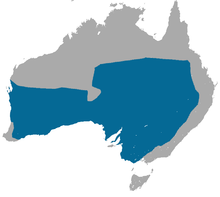Fat-tailed dunnart
| Fat-tailed dunnart | |
|---|---|
 |
|
| Scientific classification | |
| Kingdom: | Animalia |
| Phylum: | Chordata |
| Class: | Mammalia |
| Subclass: | Marsupialia |
| Order: | Dasyuromorphia |
| Family: | Dasyuridae |
| Genus: | Sminthopsis |
| Species: | S. crassicaudata |
| Binomial name | |
|
Sminthopsis crassicaudata (Gould, 1844) |
|
 |
|
| Fat-tailed dunnart range | |
The fat-tailed dunnart (Sminthopsis crassicaudata) is a species of mouse-like marsupial of the Dasyuridae, the family that includes the little red kaluta, quolls, and the Tasmanian devil. It has an average body length of 60–90 millimeters (2.4–3.5 in) with a tail of 45–70 millimeters (1.8–2.8 in). Ear length is 14–16 millimeters (0.55–0.63 in). One of the smallest carnivorous marsupials, its weight varies between 10–20 grams (0.35–0.71 oz). The tail becomes fat a few mm from the proximal end and remains so right up to the tip.
The range of S. crassicaudata in Australia is in diverse habitats except for the Kimberley region of Western Australia and northern Northern Territory like Arnhem Land and Kakadu National Park, but avoids the Wannon and Mallee scrub habitats in Victoria. In the northeast of Victoria, the species can also be found in grassy woodlands and samphire shrublands. The subspecies S. c. crassicaudata is in the Epping Forest National Park in Queensland. S. c. ferruginea is found around Lake Eyre in South Australia. S. c. centralis is found in Killalpannina (as Killalpanima, Lake Eyre East), SA.Fat tailed dunnarts can be found in most deserts in Australia, e.g. the Simpson Desert and Gibson Desert.
The habitats in which the species can be found include sparse grasslands, open shrublands and farmlands where there is considerable bare land. The impact of unimproved farming has been positive for this species as the type of habitat created is suitable to this dunnart's requirements, but intensive agriculture is seen as a negative factor for the species.
...
Wikipedia

